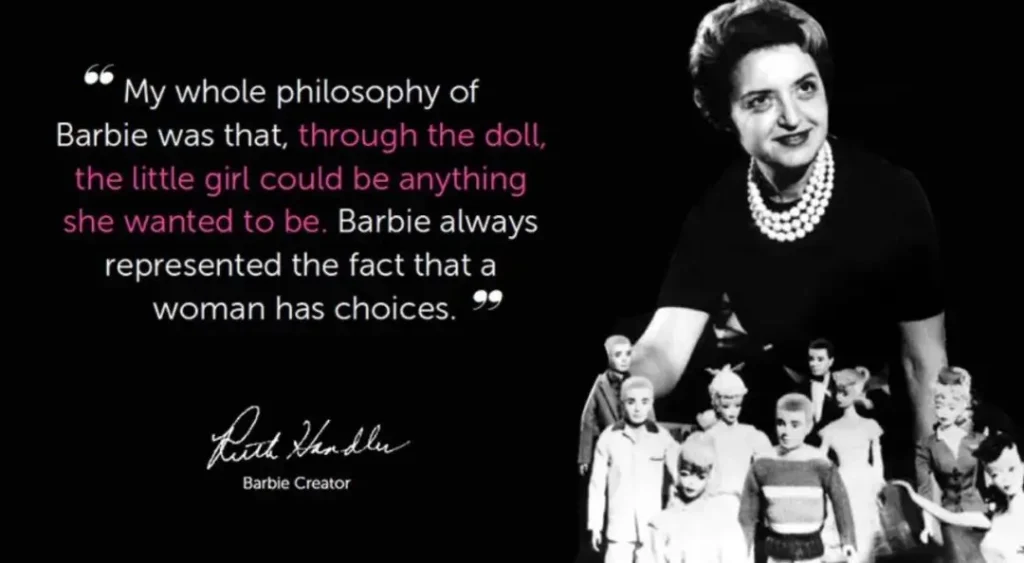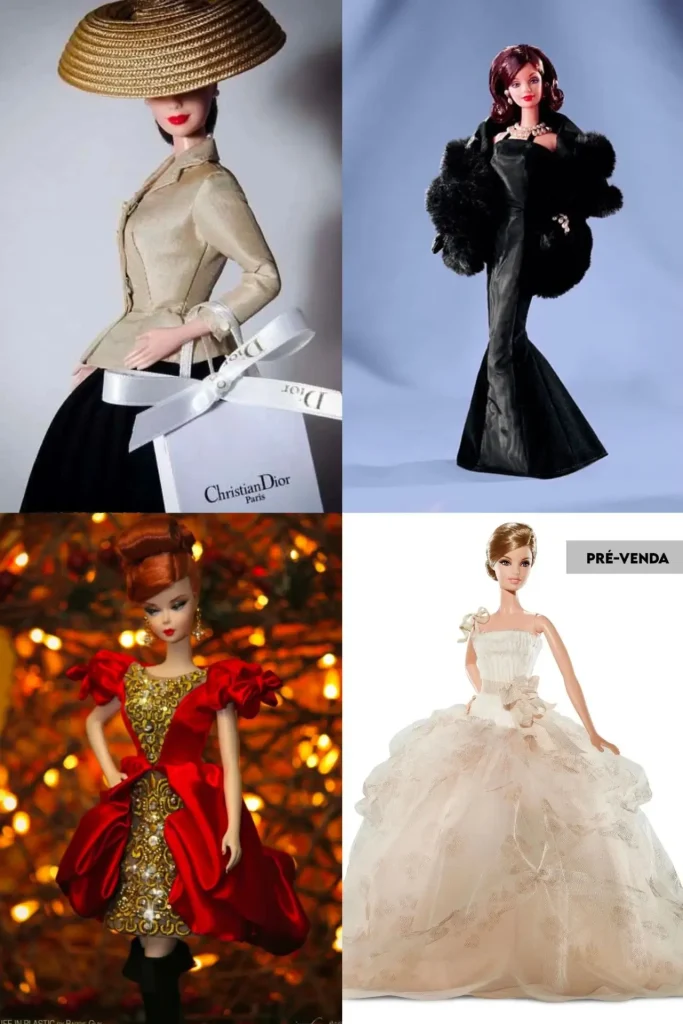Table of Contents
In recent weeks, you could probably see Barbie pink just about anywhere you least expected it.
Whether it’s at the movie theater, the mall, on the weekend’s pedestrian street, or even on a colleague’s phone case. And all of this is because of the release of the live-action Barbie movie.
The promotion of this movie can be described as igniting a massive wave of pink. Not only did the film meticulously recreate the Barbie world, but also hundreds of brands joined forces to bring Barbie pink to every corner of the real world. It makes one wonder if it’s all just a bubble inflated by money or if Barbie is truly on fire.
We’re not here to delve into whether “Barbie” is a qualified feminist film for the new era, but after the movie’s release, we can almost be certain that Barbie isn’t outdated.
In March 1959, Barbie made her debut wearing a white striped swimsuit, with bright red lips and stylish golden ponytail as her signature. As the first doll with adult features, Barbie quickly became popular in America. According to data revealed by The Economist in 2002, American girls aged 3 to 11 each owned an average of 10 Barbie dolls; by 2009, global Barbie doll sales had exceeded 1 billion, with nine out of ten American girls owning a Barbie doll.
Today, Barbie still holds a special place in the hearts of countless girls. Besides being a symbol of pink teenage dreams, it also reflects the real experiences of girls.
In her 64 years of existence, Barbie has faced several declines in sales and has been questioned for her values, resisted by women seeking freedom and independence. But why is she still going strong? Delving into Barbie’s story reveals the remedy that the brand/IP found to resist time.
01 Becoming every girl’s dream, Barbie did three things right.
Analyzing a brand cannot be separated from the logic of the 4Ps. Since its inception, Barbie has been at the forefront of product, price, and marketing.
Speaking of Barbie, one cannot bypass the toy manufacturer “Mattel” and its founder, Ruth Handler.
As one of the world’s largest toy manufacturers, Mattel’s famous IPs include Fisher-Price, Hot Wheels, Matchbox, Thomas, and of course, Barbie.

Ruth Handler, the mother of Barbie, was also one of the co-founders of Mattel. She was raised somewhat independently as her mother was 40 years old when she was born and was too weak to care for her. Ruth grew up playing with rough boys and often helped out at the family’s drugstore and soda fountain, nurturing her sales skills from childhood.
In her autobiography, she wrote, “Whenever I walked into a store with samples and walked out with an order, my adrenaline surged.”
At 16, she met her future partner, Elliot Handler, who was a struggling artist fond of experimenting with various plastic materials. Ruth’s family did not approve of their relationship, so Ruth eloped with him from Colorado to Los Angeles.
Elliot’s design skills combined with Ruth’s sales ability became the smallest entrepreneurial unit. Together with their friend Harold Matson, they founded Mattel, initially selling toy furniture, toy pianos, plastic guns, and similar products.
The success of Barbie stemmed from Ruth’s accurate insight into user psychology.
One day, Ruth noticed her daughter dressing up a paper doll. At the time, the children’s toy market wasn’t lacking in dolls, but most dolls were infantile in form, allowing girls to feed and change diapers for them, essentially encouraging girls to become mothers.
However, in the 1950s, teenage girls weren’t thinking about becoming mothers; they just wanted to grow up a bit more, to freely choose their own clothes and accessories. For girls, Barbie represented rebellion.
Barbie dolls were born targeting this user mentality. Ruth Handler once wrote in her autobiography in 1994, “My whole philosophy of Barbie was that, through the doll, the little girl could be anything she wanted to be.”

Therefore, Barbie had to have an adult figure. When designing Barbie, Ruth also consulted with branding expert and psychologist Ernest Dichter, who suggested making the doll’s bust a bit larger. Although mothers didn’t like it, children would adore it.
However, this idea was not supported. Mattel’s executive committee—composed entirely of men except for Ruth—opposed the idea. When she presented this concept to an external advertising agency, their feedback was, “Are you kidding? This will never work!”
At this point, Ruth embodied the boldness and rebellion of adolescence, and forcefully pushed Mattel’s R&D department to design and produce this doll. In 1959, Barbie made her debut at the largest toy fair in the United States, priced almost at cost, at $3 each.
This was the second key to Barbie’s successful cold start—selling dolls at an extremely low price to capture the market, while making money from accessories. Data indicates that doll owners in the United States spend an average of $300 on accessories per doll.
This business model, which is commonplace today, was a very radical approach in the U.S. toy market over 70 years ago.
Another radical move happened earlier. In 1955, Mattel became the first toy company to advertise to children, with Ruth spending the company’s last $500,000 sponsoring Disney Channel’s “The Mickey Mouse Club,” which later spawned international stars like Ryan Gosling, Justin Timberlake, and Britney Spears.
Before this, toy companies targeted parents as their customers, with the rhetoric being “buy this for your kids”; moreover, toy companies’ advertising budgets were mostly spent on promoting individual items around Christmas. However, Mattel chose to directly engage with children, advertising on TV programs year-round.
After the “The Mickey Mouse Club” animation ended in 1959, Barbie’s advertisement would immediately follow: “Someday I’m going to be exactly like you, until then I know I’m going to be me, Barbie, beautiful Barbie, I’ll make you believe that I am you.”

As a result, Barbie sold over 300,000 dolls in her first year on the market, directly assisting Mattel’s IPO a year later, with a valuation of $10 million.
02 Imprinting the product with the mark of the times, Barbie’s controversies and longevity
Since Barbie’s birth in 1959, wearing her first black and white striped swimsuit, Mattel has continuously released new doll images. They have diverse identities, including boyfriend Ken, as well as friends appearing as fashion editors, nurses, flight attendants, and more.
Echoing her starting point of “letting little girls become anyone they want to be,” when she became a surgeon, only 9% of doctors in America were female; even in 1965, a Barbie astronaut was launched, 20 years before Sally Ride became the first American woman to enter space aboard the Challenger space shuttle in 1983.
Gradually, Barbie became not just the name of a doll, but a synonym for this category.
But Barbie’s subsequent development was not as smooth as her cold start. In the sixties and seventies, Barbie’s image encountered fierce criticism from public opinion.
In the 1970s, Barbie sales declined for the first time, which coincided with the flourishing of the second wave of feminism in America. Feminists pointed out that Barbie was the earliest exposure to beauty standards for many women, and that this image actually promoted “unrealistic body ideals and outdated gender stereotypes.”
For example, Barbie’s measurements are 36-24-36; if she were a real woman, she wouldn’t have enough body fat to menstruate. Attempts to recreate Barbie in 3D resulted in a doll whose neck was too thin, causing her head to fall off.
For instance, a diet guide included with a certain model of Barbie suggested not eating.
Radical feminists argued that Barbie was a product of patriarchal objectification of women, and “refuse to be Barbie” became a slogan at the time.
To address the periodic sales decline, in the 1980s, Mattel actively invited major fashion brands to create high-end clothing lines for Barbie, collaborating with brands such as Dior, Alexander McQueen, Givenchy, Vera Wang, Giorgio Armani, Celine, Valentino, Yves Saint Laurent, and many more.

This initiative greatly boosted Barbie’s momentum, making Barbie culture popular worldwide.
In recent years, Barbie has been continuously expanding the diversity of her IP image. For example, in 2016, Mattel launched “The Doll Evolves” series, creating three body shapes: Curvy, Tall, and Petite, as well as seven skin tones, 22 eye colors, and 24 hairstyles to break away from the past image of the perfect Barbie doll.
By 2018, Mattel introduced more Role Model models, encouraging girls to break through the glass ceiling with over 200 types of jobs. As Barbie’s website puts it, “By introducing girls to stories of women in all fields, they begin to see more opportunities for themselves.”
The diversification strategy worked. In 2021, with the demand for Barbie dolls skyrocketing due to the pandemic-induced stay-at-home orders, Mattel sold 86 million dolls from the Barbie family, equivalent to selling 164 dolls every minute.

Facing the competition for children’s attention from the internet today, Barbie, like all toy companies, has experienced a decline in performance. Consequently, Barbie has also ventured further into the world of film and television. The live-action Barbie movie, announced in 2019, was finally released this year.
Typically, a toy company is considered successful if it lasts 3-5 years; Barbie has been a hit for over 60 years, to some extent becoming an embodiment of the American dream.
03 How does a brand/IP find a remedy against time?
Whenever an IP reappears across generations, people often attribute its popularity to “nostalgia.” However, Barbie believes that for an IP to withstand the test of time and become the nostalgia of a generation, there must be a stronger core behind it.
Nostalgia can be consumed and easily depleted. Fashion trends are constantly evolving, so how can a brand be remembered? Barbie’s answer is to become a cultural symbol, even an imprint of an era.
In her 65 years of existence, Barbie’s total sales have exceeded 1 billion, spanning 150 countries worldwide. She has been questioned and resisted for her overly perfect image, ultimately becoming a symbol of female freedom and independence. Barbie’s image has gradually become fuller with the development of the times, accompanying a generation’s growth, becoming their ideal.
Whether it’s branding or IP, you can learn from Barbie’s story. In terms of specific operational methods, we have summarized three methodologies applicable to most brands/IPs.
Find the sentiment of the times and shape a distinct image
Talking about brand positioning ultimately cannot be separated from the three questions of the soul—who am I? Who do I exist for? Why should people buy me?
Barbie’s distinct image is obvious to all, and her popularity owes much to capturing the sentiment of the times. Knowing who you are and creating enough reasons for people to bring you home.
Barbie was born in 1959, at the beginning of the second wave of feminism. Many women began to leave their homes, pursue higher education, and become career women. Compared to traditional dolls, Barbie dolls were the first to liberate girls from the roles of “mother” and “caretaker” and simply allowed them to “be a girl.”
Have an open mindset for collaborations and give material form to the spiritual core
Transmitting brand values and spiritual cores requires a certain material carrier. On one hand, it involves forming unique brand expressions through content composed of texts, videos, etc. On the other hand, it involves conveying brand concepts to more people through collaborative partnerships.
Since her birth, Barbie has maintained a highly open-minded attitude towards IP collaborations. The types of brands she collaborates with are diverse, ranging from luxury to fast fashion, and even including cars, jewelry, cosmetics, personal care, accessories, food… There are over 100 co-branded brands with Barbie.
Taking the time before the recent movie release as an example, there were collaborations with Chanel, Versace, Zara, Forever 21, and other brands. Airbnb even replicated a real-life Barbie room on Malibu Beach in California.
These brands drew inspiration from the Barbie IP, and the Barbie style has continued to this day.
Repeat visual cues to strengthen mental impressions
After the announcement of the “Barbie” movie poster, it was joked as the “most economical designer” poster. Besides the full Barbie pink background, there were no other elements. Yet, everyone could immediately recognize it as Barbie.

This is the power of visual cues. By using iconic colors and patterns, people form their first associations with a brand/IP.
There aren’t many brands that can name colors after themselves like Barbie. To find a memorable visual cue, you first need to answer the initial question: who are you? Colors and patterns themselves have no meaning; it’s your personality and values that give them life.
04 Analyst’s Comments
In the first quarter of 2023, Mattel’s revenue in the Americas and Europe plummeted, with Barbie doll sales falling by 41% year-on-year. This isn’t the first time Barbie has faced a sales crisis. We can’t deny that the “Barbie” movie is one of the means to stimulate sales, as well as a concentrated expression of IP concepts.
In this movie, Barbie is also portrayed as a woman unlike any other era before her. At the end of the film, Barbie faces the choice of wearing high heels or flats. Isn’t this the question every girl who owns a Barbie doll would face?
In another 50 years, Barbie leaves girls not just a pile of old dolls. As long as the brand spirit continues, even if sales temporarily decline, there is confidence in a comeback.
